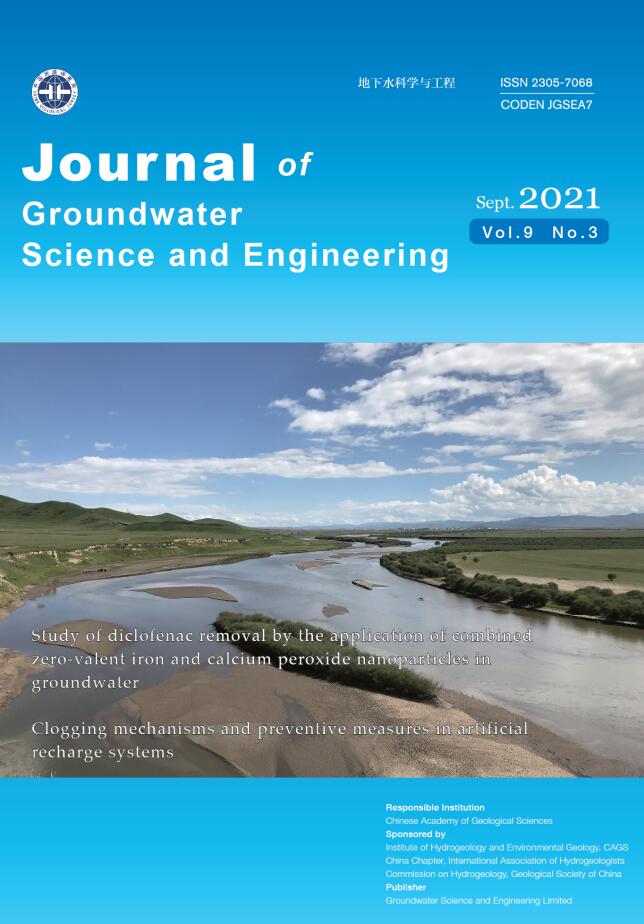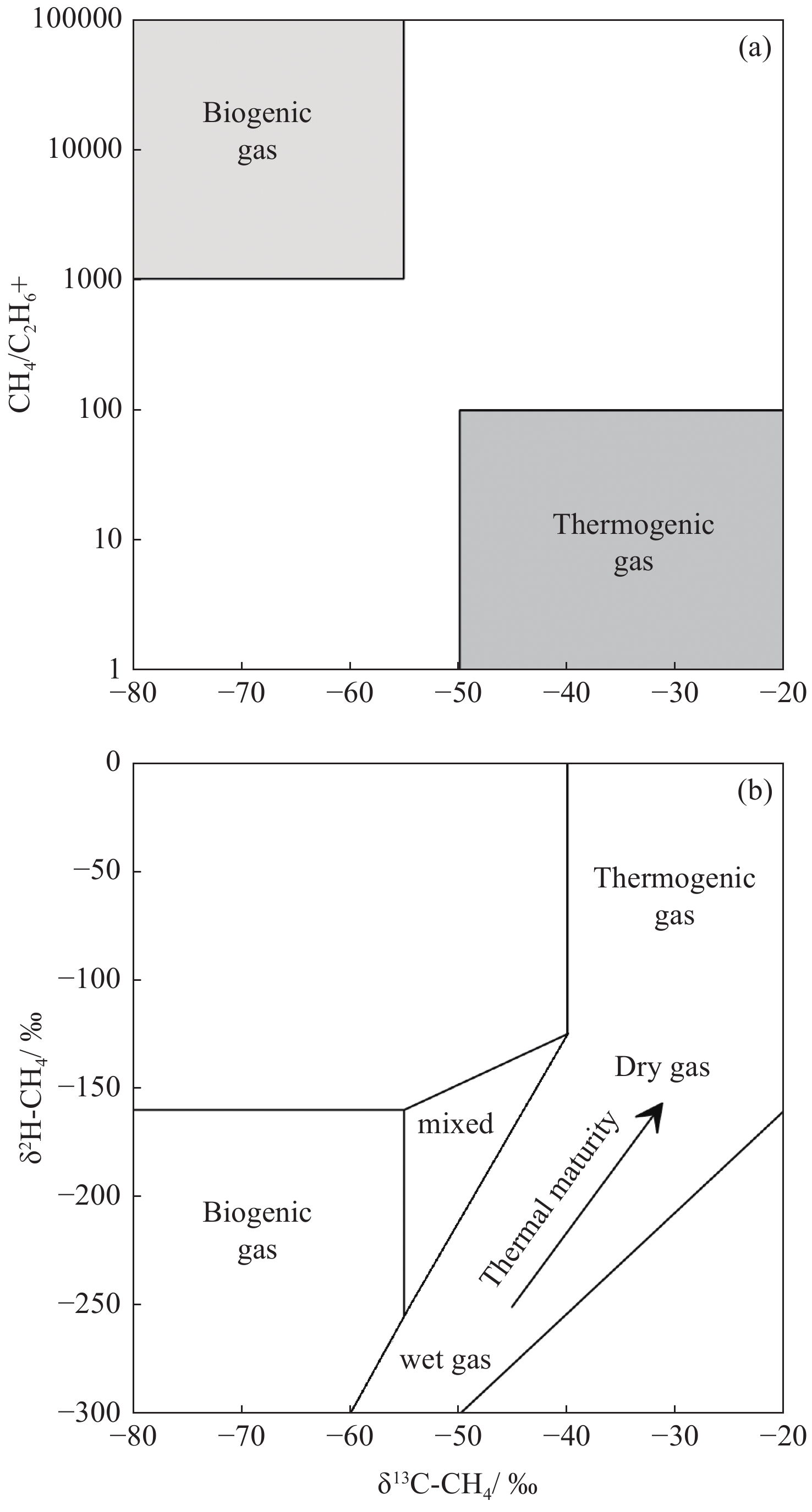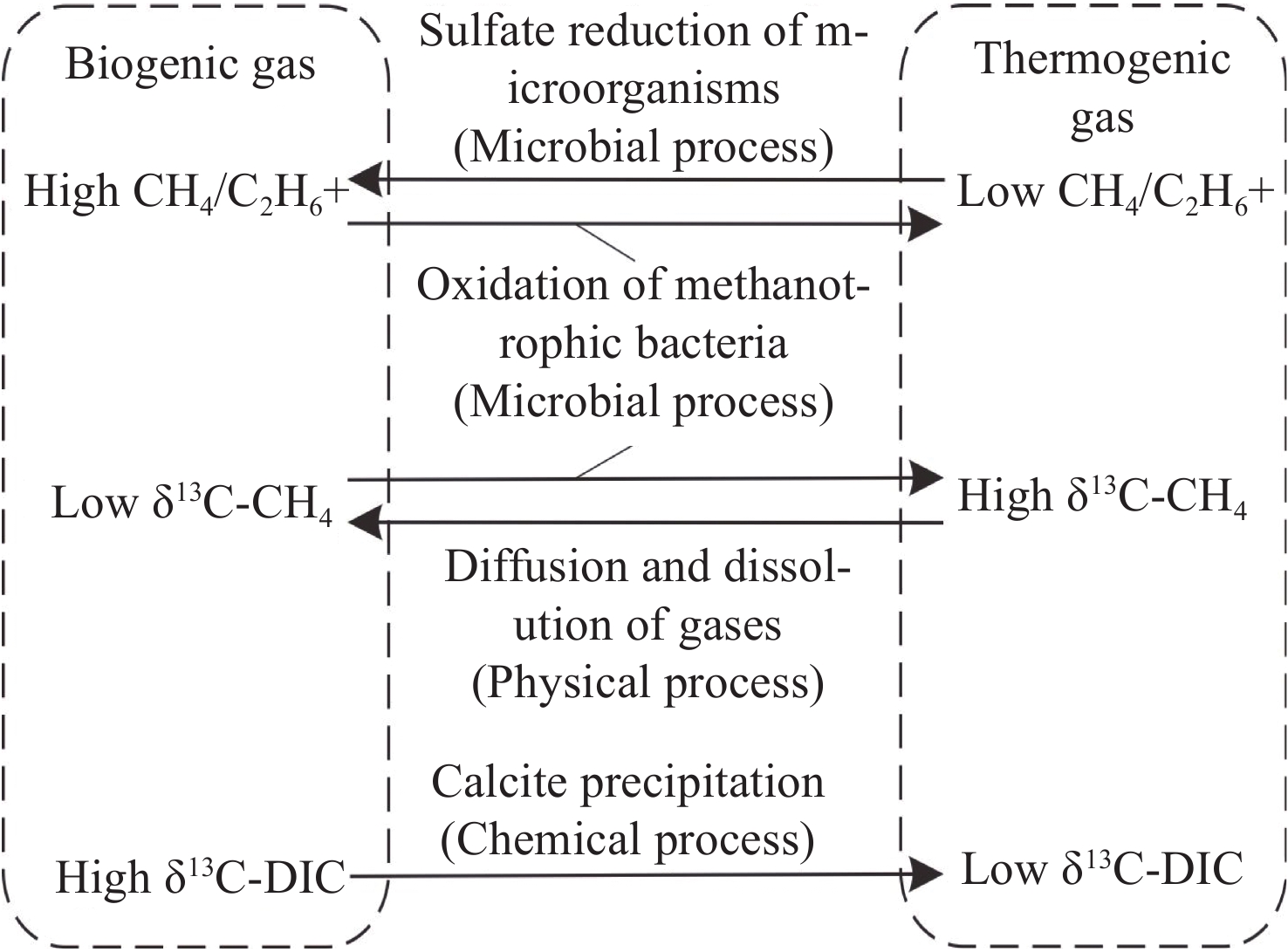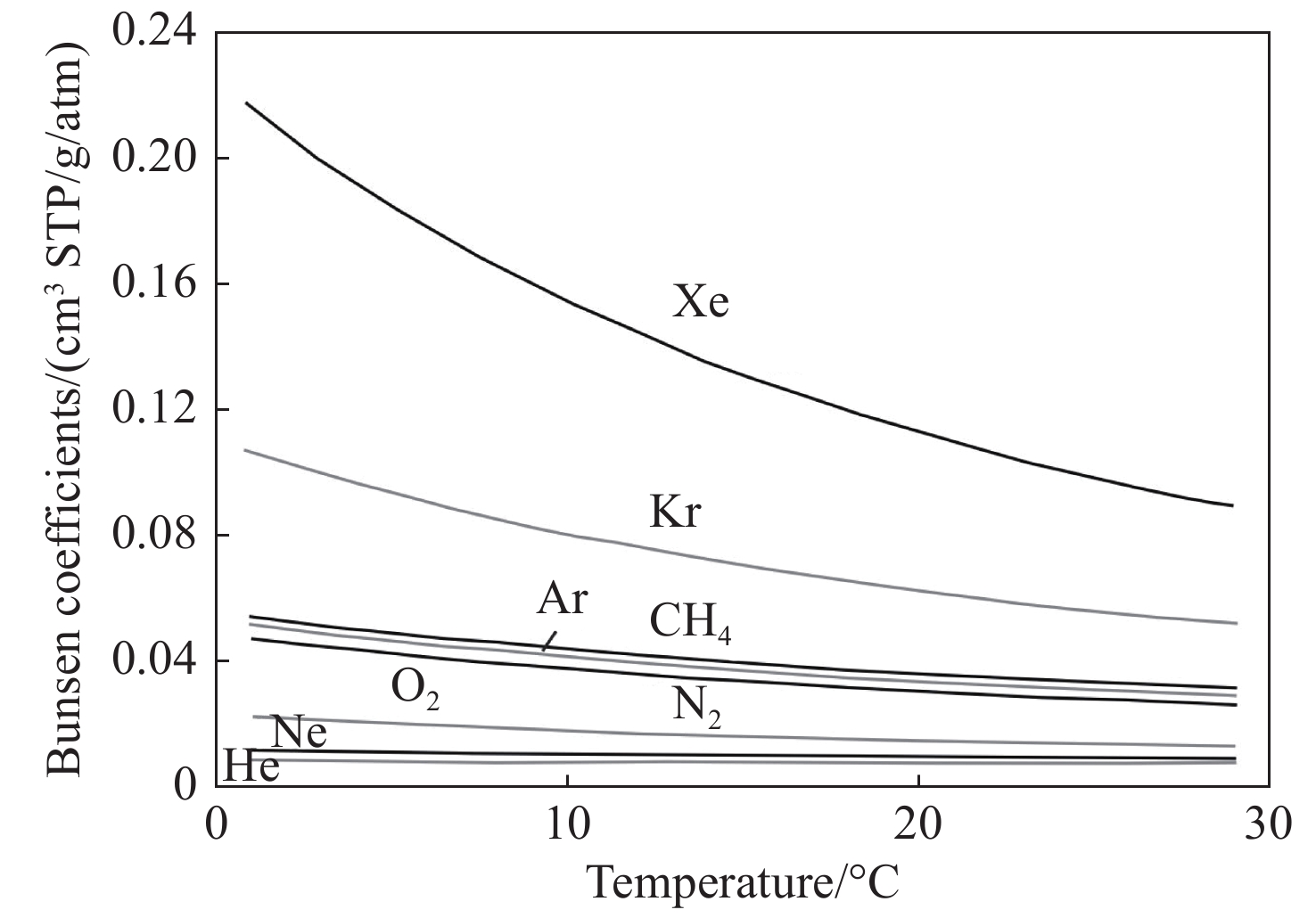| Citation: | Zheng Zhao-xian, Liu Ling-xia, Cui Xiao-shun. 2021. Source identification of methane in groundwater in shale gas development areas: A critical review of the state of the art, prospects, and future challenges. Journal of Groundwater Science and Engineering, 9(3): 245-255. doi: 10.19637/j.cnki.2305-7068.2021.03.007 |
Source identification of methane in groundwater in shale gas development areas: A critical review of the state of the art, prospects, and future challenges
-
Abstract
Shale gas exploration and development carry the risk of causing groundwater contamination and enhancing the greenhouse effect through methane leakage. Identifying the source of abnormal methane in groundwater of shale gas development areas is becoming a research hotspot in the fields of groundwater and climate change. This paper reviews the traditional methodology in identifying sources of methane and its deficiency in groundwater application. Then potential and advantages of using noble gases were discussed on how to overcome these limitations of the traditional method. Finally, based on noble gas, the current application status and future challenges of methane source identification in groundwater were analyzed. It can be summarized as: (1) due to chemical and/or microbial processes in the aquifer system, the traditional methodology for methane source identification, which utilizes molecular and isotopic compositions of hydrocarbon gas, has multiple interpretationsand large uncertainties; (2) the non-reactive nature and well-characterized isotopic compositions of noble gases in the atmosphere, hydrosphere, and crust, make noble gases ideal indicators of the sources of methane in groundwater. Moreover, the mechanism of formation and release of crustal noble gas prevent shale gas signatures from being interfered with by natural gas; (3) the key scientific tasks surrounding the use of noble gases for methane source identification include quantitatively separating the components of atmosphere-derived, mantle-derived, and crust-derived noble gases from the bulk noble gases in groundwater. It quantifies the solubility fractionation of noble gases induced by water-gas interaction during methane migration to the aquifer. The application of noble gases can bring a new perspective to tracing the source of methane in groundwater and is of great significance to the protection of groundwater quality in shale gas development areas and mitigation of climate change.
-
Keywords:
- Noble gas /
- Isotope /
- Source identification of methane /
- Shale gas /
- Groundwater
-

-
References
[1] Abanda PA, Hannigan RE. 2006. Effect of diagenesis on trace-element partitioning in shales. Chemical Geology, 230: 42-59. doi: 10.1016/j.chemgeo.2005.11.011 [2] Aeschbach-Hertig W, Peeters F, Beyerle U, et al. 1999. Interpretation of dissolved atmospheric noble gases in natural waters. Water Resources Research, 35(9): 2779-2792. doi: 10.1029/1999WR900130 [3] Aeschbach-Hertig W, Peeters F, Beyerle U, et al. 2000. Palaeotemperature reconstruction from noble gases in ground water taking into account equilibration with entrapped air. Nature, 405: 1040-1044. doi: 10.1038/35016542 [4] Alvarez RA, Zavalao-Araiza D, Lyon DR. 2018. Assessment of methane emissions from the U.S. oil and gas supply chain. Science, 361: 186-188. doi: 10.1126/science.aar7204 [5] Bai B, Cheng YP, Jiang ZC, et al. 2017. Climate change and groundwater resources in China. Journal of Groundwater Science and Engineering, 5(1): 44-52. doi: 10.19637/j.cnki.2305-7068.2017.01.004 [6] Ballentine CJ, Burgess R, Marty B. 2002a. Tracing fluid origin, transport and interaction in the crust. Reviews in Mineralogy and Geochemistry, 47(1): 539-614. doi: 10.2138/rmg.2002.47.13 [7] Ballentine CJ, Burnard PG. 2002b. Production, release, and transport of noble gases in the continental crust. Reviews in Mineralogy and Geochemistry, 47(1): 481-538. doi: 10.2138/rmg.2002.47.12 [8] Ballentine CJ, Mazurek M, Gautschi A. 1994. Thermal constraints on crustal rare-gas release and migration: Evidence from alpine fluid inclusions. Geochimica et Cosmochimica Acta, 58(20): 4333-4348. doi: 10.1016/0016-7037(94)90337-9 [9] Battani A, Sarda P, Prinzhofer A. 2000. Basin-scale natural gas source, migration and trapping traced by noble gases and major elements: The Pakistan Indus Basin. Earth and Planetary Science Letters, 181(1-2): 229-249. doi: 10.1016/S0012-821X(00)00188-6 [10] Bordeleaua G, Rivarda C, Lavoiea D, et al. 2015. Identifying the source of methane in groundwater in a ‘virgin’ area with regards to shale gas exploitation: A multi-isotope approach. Procedia Earth and Planetary Science, 13: 219-222. doi: 10.1016/j.proeps.2015.07.052 [11] Byrne DJ, Barry PH, Lawson M, et al. 2017. Noble gases in conventional and unconventional petroleum systems. Geological Society London Special Publications: 468. DOI: 10.1144/SP468.5 [12] Byrne DJ, Broadley MW, Halldórsson SA, et al. 2021. The use of noble gas isotopes to trace subsurface boiling temperatures in Icelandic geothermal systems. Earth and Planetary Science Letters, 560: 116805. doi: 10.1016/j.jpgl.2021.116805 [13] Cao CH, Li LW, Li D, et al. 2020b. The use of noble gas isotopes in detecting methane contamination of groundwater in shale gas development areas: An overview of technology and methods. Analytical Sciences, 36(5): 521-530. doi: 10.2116/analsci.19SBR01 [14] Cao CH, Zhang MJ, Li LW. 2020a. Tracing the sources and evolution processes of shale gas by coupling stable (C, H) and noble gas isotopic compositions: Cases from Weiyuan and Changning in Sichuan Basin, China. Journal of Natural Gas Science and Engineering, 78: 103304. doi: 10.1016/j.jngse.2020.103304 [15] Chung HM, Gormly JR, Squires RM. 1988. Origin of gaseous hydrocarbons in subsurface environments: Theoretical considerations of carbon isotope distribution. Chemical Geology, 71: 97-103. doi: 10.1016/0009-2541(88)90108-8 [16] Cui XS, Zheng ZX, Zhang HD, et al. 2020. Impact of water-rock interactions on indicators of hydraulic fracturing flowback fluids produced from the Jurassic shale of Qaidam Basin. NW China. Journal of Hydrology, 590: 125541. doi: 10.1016/j.jhydrol.2020.125541 [17] Dai JX. 2011. Significant of the study on carbon isotopes of alkane gases. Natural Gas In-dustry, 31(12): 1-6. [18] Darrah TH, Jackson RB, Vengosh A, et al. 2015b. The evolution of Devonian hydrocarbon gases in shallow aquifers of the northern Appalachian Basin: Insights from integrating noble gas and hydrocarbon geochemistry. Geochimica et Cosmochimica Acta. DOI: 170: 321-355. 10.1016/j.gca.2015.09.006 [19] Darrah TH, Tedesco D, Tassi F, et al. 2013. Gas chemistry of the Dallol region of the Danakil depression in the Afar region of the northern-most East African Rift. Chemical Geology, 339: 16-29. doi: 10.1016/j.chemgeo.2012.10.036 [20] Darrah TH, Vengosh A, Jackson RB, et al 2015a. Noble gases: A new technique for fugitive gas investigation in groundwater. Groundwater, 3(1): 23-28. PMID: 25713829 [21] Darrah TH, Vengosh A, Jackson RB, et al. 2014. Noble gases identify the mechanisms of fugitive gas contamination in drinking-water wells overlying the Marcellus and Barnett Shales. Proceedings of the National Academy of Sciences of the USA, 111(39): 14076-14081. doi: 10.1073/pnas.1322107111 [22] Dowling CB, Poreda RJ, Basu AR, et al. 2002. Geochemical study of arsenic release mechanisms in the Bengal Basin groundwater. Water Resources Research, 38: 12-1-12-18. doi: 10.1029/2001WR000968 [23] Gilfillan SMV, Lollar BS, Holland G, et al. 2009. Solubility trapping in formation water as dominant CO2sink in natural gas fields. Nature, 458: 614-618. doi: 10.1038/nature07852 [24] Gvakharia A, Kort EA, Brandt A, et al. 2017. Methane, black carbon, and ethane emissions from natural gas flares in the Bakken Shale, North Dakota. Environmental Science & Technology, 51: 5317-5325. doi: 10.1021/acs.est.6b05183 [25] Horstmann E, Tomonage Y, Brennwald MS, et al. 2021. Noble gases in sediment pore water yield insights into hydrothermal fluid transport in the northern Guaymas Basin. Marine Geology, 434: 106419. doi: 10.1016/j.margeo.2021.106419 [26] Howarth RW. 2019. Ideas and perspectives: Is shale gas a major driver of recent increase in global atmospheric methane? Biogeosciences, 16: 3033-3046. [27] Huang TM, Pang ZH, Tian J, et al. 2017. Methane content and isotopic composition of shallow groundwater: Implication for environmental monitoring related to shale gas exploitation. Journal of Radioanalytical and Nuclear Chemistry, 312: 577-585. doi: 10.1007/s10967-017-5243-9 [28] Hunt AG, Darrah TH, Ppreda RJ. 2012. Determining the source and genetic fingerprint of natural gases using noble gas geochemistry: A Northern Appalachian Basin case study. AAPG Bulletin, 96: 1785-1811. doi: 10.1306/03161211093 [29] Hunt AG. 2000. Diffusional release of helium-4 from mineral phases as indicators of groundwater age and depositional history. Ph.D. thesis. Rochester: University of Rochester. [30] Jackson RB, Saunois M, Bousquet P, et al. 2020. Increasing anthropogenic methane emissions arise equally from agricultural and fossil fuel sources. Environmental Research, 15(7): 071002. doi: 10.1088/1748-9326/ab9ed2 [31] Ju Y, Gilfillan SMV, Lee S, et al. 2020. Application of noble gas tracers to identify the retention mechanisms of CO2 migrated from a deep reservoir into shallow groundwater. International Journal of Greenhouse Gas Control, 97: 103041. doi: 10.1016/j.ijggc.2020.103041 [32] Kessler JD, Reeburgh WS, Tyler SC. 2006. Controls on methane concentration and stable isotope (d2H-CH4 and d13C-CH4) distributions in the water columns of the Black Sea and Cariaco Basin. Global Biogeochemical Cycles, 20: 1-13. doi: 10.1029/2005GB002571 [33] Le M. 2018. An assessment of the potential for the development of the shale gas industry in countries outside of North America. Heliyon, 4(2): e00516. doi: 10.1016/j.heliyon.2018.e00516 [34] Martini AM, Walter LM, Budai JM, et al. 1998. Genetic and temporal relations between formation waters and biogenic methane: Upper Devonian Antrim Shale, Michigan Basin, USA. Geochimica et Cosmochimica Acta, 62(10): 1699-1720. doi: 10.1016/S0016-7037(98)00090-8 [35] Mclntosh J, Hendry MJ, Ballentine CJ, et al. 2019. A critical review of state-of-the-art and emerging approaches to identify fracking-derived gases and associated contaminants in aquifers. Environmental Science & Technology, 53(3): 1063-1077. doi: 10.1021/acs.est.8b05807 [36] Nisbet EG, Manning MR, Dlugokencky EJ. 2019. Very strong atmospheric methane growth in the 4 years 2014–2017: Implications for the Paris Agreement. Global Biogeochemical Cycles, 33: 318-342. doi: 10.1029/2018GB006009 [37] Osborn SG, Mclntosh JC. 2010. Chemical and isotopic tracers of the contribution of microbial gas in devonian organic-rich shales and reservoir sandstones, Northern Appalachian Basin. Applied Geochemistry, 25: 456-471. doi: 10.1016/j.apgeochem.2010.01.001 [38] Osborn SG, Vengosh A, Warner NR, et al. 2011. Methane contamination of drinking water accompanying gas-well drilling and hydraulic fracturing. Proceedings of the National Academy of Sciences of the USA, 108(20): 8172-8176. doi: 10.1073/pnas.1100682108 [39] Ozima M, Podosek FA. 2002. Noble gas geochemistry. Cambridge: Cambridge University Press. [40] Pape T, Bahr A, Rethemeyer J, et al. 2010. Molecular and isotopic partitioning of low-molecular-weight hydrocarbons during migration and gas hydrate precipitation in deposits of a high-flux seepage site. Chemical Geology, 269: 350-363. doi: 10.1016/j.chemgeo.2009.10.009 [41] Pietersen K, Chevallier L, Levine A, et al. 2021. Prospective policy safeguards to mitigate hydrogeological risk pathways in advance of shale gas development in the Karoo basin, South Africa. Groundwater for Sustainable Development, 12: 100499. doi: 10.1016/j.gsd.2020.100499 [42] Qu ZY. 2015. Shale gas generation and variation in stable carbon and hydrogen isotope compositions. M.S. thesis. Guangzhou: Guangzhou Institute of Geochemistry, Chinese Academy of Sciences: 22. (in Chinese) [43] Rivard C, Bordeleau G, Lavoie D, et al. 2019. Assessing potential impacts of shale gas development on shallow aquifers through upward fluid migration: A multi-disciplinary approach applied to the Utica Shale in eastern Canada. Marine and Petroleum Geology, 100: 466-483. doi: 10.1016/j.marpetgeo.2018.11.004 [44] Saunois M, Jackson RB, Bousquet P, et al. 2016. The Growing role of methane in anthropogenic climate change. Environmental Research Letters, 11: 120207. doi: 10.1088/1748-9326/11/12/120207 [45] Schoell M. 1980. The hydrogen and carbon isotopic composition of methane from natural gases of various origins. Geochimica et Cosmochimica Acta, 44: 649-661. doi: 10.1016/0016-7037(80)90155-6 [46] Solomon DK, Hunt A, Poreda RJ. 1996. Source of radiogenic helium-4 in shallow aquifers: Implications for dating young groundwater. Water Resources Research, 32(6): 1805-1813. doi: 10.1029/96WR00600 [47] Sun D, Liu XZ, Yang HJ, et al. 2019. Analysis of hydrogeolgical characteristics and water environmental impact pathway of typical shale gas exploration and development zones in Sichuan Basin, China. Journal of Groundwater Science and Engineering, 7(3): 195-213. doi: 10.19637/j.cnki.2305-7068.2019.03.001 [48] Sun HB, Xie H. 2010. Investigation and risk assessment of methane in shallow groundwater. Shanghai Geology, 31(4): 68-72. (in Chinese) doi: 10.3969/j.issn.2095-1329.2010.04.013 [49] Sun SJ. 2017. Methane emission from municipal solid waste in China. Science and Technology Herald, 16: 145-146. (in Chinese) doi: 10.16660/j.cnki.1674-098X.2017.16.145 [50] Tollefson J. 2013. China slow to tap shale-gas bonanza. Nature, 494(7437): 294-294. doi: 10.1038/494294a [51] Turner JV. 1982. Kinetic fractionation of carbon-13 during calcium carbonate precipitation. Geochimica et Cosmochimica Acta, 46: 1183-1191. doi: 10.1016/0016-7037(82)90004-7 [52] USA Eenvironmental Protection Agency. 2016. Hydraulic Fracturing for Oil and Gas: Impacts from the Hydraulic Fracturing Water Cycle on Drinking Water Resources in the United States (Final Report): EPA/600/R–16/236F. Washington, DC: USA Environmental Protection Agency. [53] Van Der Hoven SJ, Solomon DK, Moline GR. 2005. Natural spatial and temporal variations in groundwater chemistry in fractured, sedimentary rocks: Scale and implications for solute transport. Applied Geochemistry, 20: 861-873. doi: 10.1016/j.apgeochem.2004.11.013 [54] Vengosh A, Jackson RB, Warner NR, et al. 2014. A critical review of the risks to water resources from unconventional shale gas development and hydraulic fracturing in the United States. Environmental Science & Technology, 48(15): 8334-8348. doi: 10.1021/es405118y [55] Wang XF, Liu WH, Li XB, et al. 2020. Radiogenic helium concentration and isotope variations in crustal gas pools from Sichuan Basin, China. Applied Geochemistry, 117: 104586. doi: 10.1016/j.apgeochem.2020.104586 [56] Wei W, Chen ZY. 2016. A review of paleoclimate records inferred from noble gas in groundwater. Advances in Science and Technology of Water Resources, 36(6): 8-13. (in Chinese) doi: 10.3880/j.issn.1006-7647.2016.06.002 [57] Wei W, Aeschbach-Hertig W, Chen ZY. 2015. Identification of He sources and estimation of He ages in groundwater of the North China Plain. Applied Geochemistry, 63: 182-189. (in Chinese) doi: 10.1016/j.apgeochem.2015.08.010 [58] Wei XL, Long HW, Tang N, et al. 2010. Analysis on the development status and advantages of rural methane in Chongqing. Agricultural Engineering Technology (New Energy Industry), 9: 26-28. doi: 10.3969/j.issn.1673-5404-C.2010.09.009 [59] Weiss R. 1971a. The effect of salinity on the solubility of argon in water and seawater. Deep Sea Research & Oceanographic Abstracts, 18: 225-230. doi: 10.1016/0011-7471(71)90111-2 [60] Weiss R. 1971b. Solubility of helium and neon in water and seawater. Journal of Chemical & Engineering Data, 16(2): 235-241. doi: 10.1021/je60049a019 [61] Wen T, Clara Castro M, Nicot J, et al. 2016. Methane Sources and Migration Mechanisms in Shallow Groundwaters in Parker and Hood Counties, Texas−A Heavy Noble Gas Analysis. Environmental Science & Technology, 50(21): 12012-12021. doi: 10.1021/acs.est.6b01494 [62] Wen T, Clara Castro M, Nicot J, et al. 2017. Characterizing the Noble Gas Isotopic Composition of the Barnett Shale and Strawn Group and Constraining the Source of Stray Gas in the Trinity Aquifer, North-Central Texas. Environmental Science & Technology, 51(11): 6533-6541. doi: 10.1021/acs.est.6b06447 [63] Wetherill GW. 1954. Variations in the isotopic abundances of neon and argon extracted from radioactive minerals. Physical Reviews, 96(3): 679-683. doi: 10.1103/PhysRev.96.679 [64] Whiticar MJ. 1999. Carbon and hydrogen isotope systematics of bacterial formation and oxidation of methane. Chemical Geology, 161: 291-314. doi: 10.1016/S0009-2541(99)00092-3 [65] Xia XY, Tang YC. 2012. Isotope fractionation of methane during natural gas flow with coupled diffusion and adsorption/desorption. Geochimica et Cosmochimica Acta, 77: 489-503. doi: 10.1016/j.gca.2011.10.014 [66] Zhang HZ. 2006. Kinetic simulation of thermogenic natural gas generation and its geological applications. Ph.D thesis. Guangzhou: Guangzhou Institute of Geochemistry, Chinese Academy of Sciences: 22. (in Chinese) [67] Zhang JC, Lei HY, Zhang F, et al. 2018a. Origin of natural gas in the low Silurian Songkan Formation. Oil & Gas Geology, 39(3): 419-428. (in Chinese) doi: 10.11743/ogg20180301 [68] Zhang MJ, Tang QY, Cao CH, et al. 2018b. Molecular and carbon isotopic variation in 3.5 years shale gas production from Longmaxi Formation in Sichuan Basin, China. Marine and Petroleum Geology, 89: 27-37. doi: 10.1016/j.marpetgeo.2017.01.023 -
Access History

-
Figure 1.
(a) Typical values of CH4/C2H6+ versus δ13C-CH4 in thermogenic and biogenic gas; (b) Typical values of δ13C-CH4 versus δ2H-CH4in thermogenic and biogenic gas.
-
Figure 2.
Impact of microbial, chemical, and physical processes on the traditional indicators of methane source, i.e. molecular and isotopic compositions of hydrocarbon and by-product gases.
-
Figure 3.
Schematic diagram of a shale gas reservoir and the methane producing layer, showing characteristic isotopic compositions in shale gas and biogenic gas. Well-characterized isotopic compositions of noble gases in the atmosphere, crust, and mantle are also plotted.
-
Figure 4.
Solubility (Bunsen coefficients) of noble gases, methane, nitrogen, and oxygen in pure water with temperature.





 DownLoad:
DownLoad:


